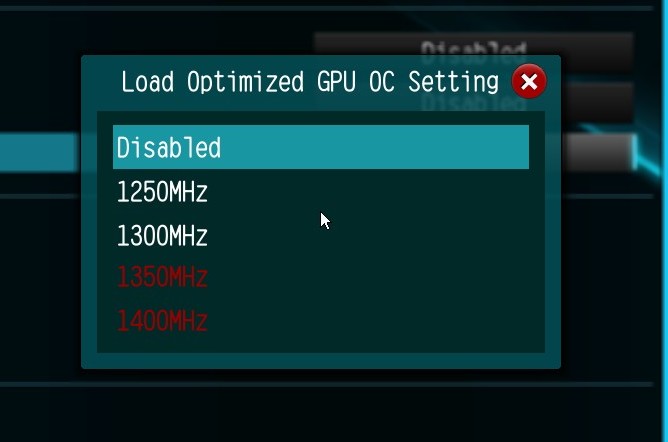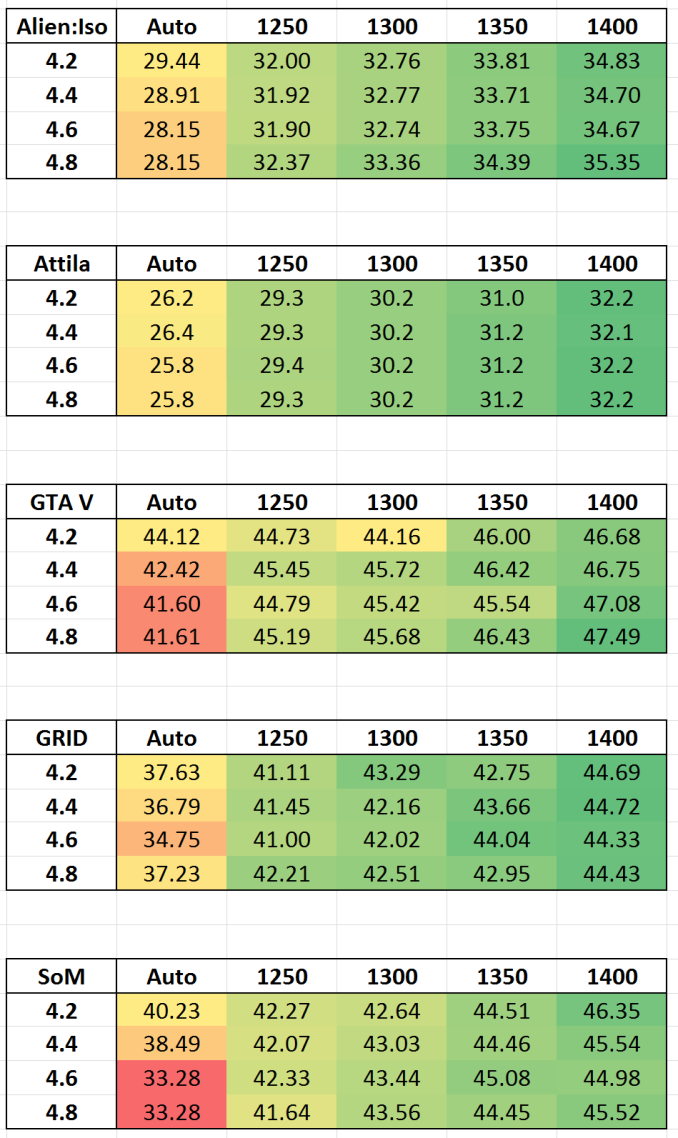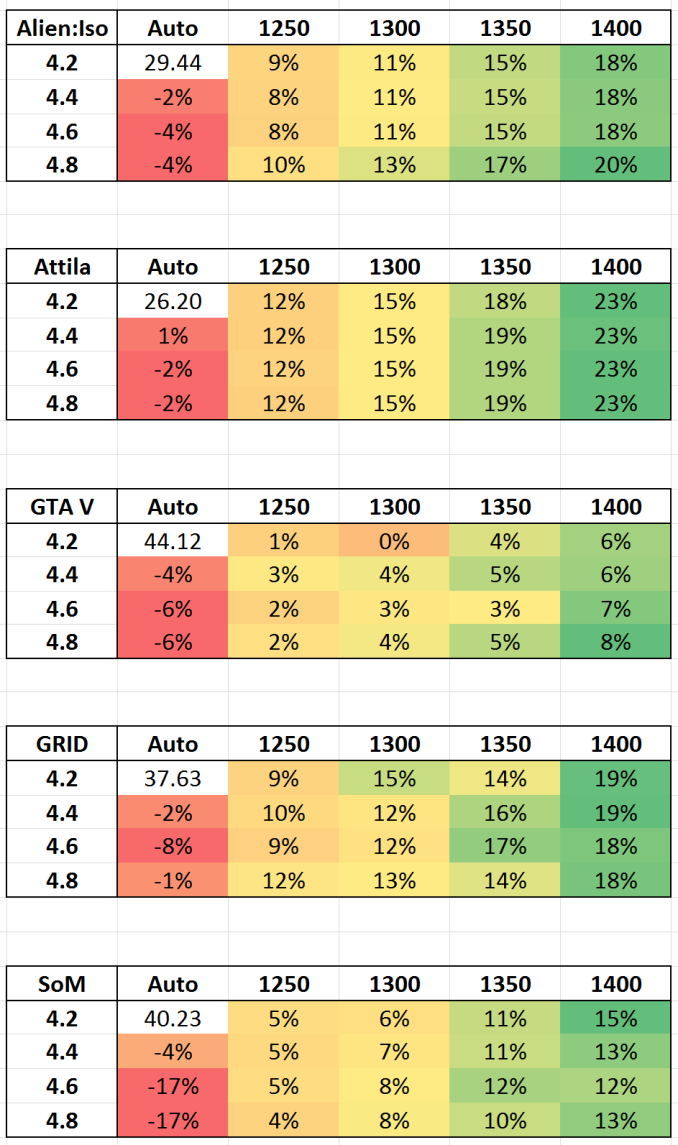The Intel Skylake i7-6700K Overclocking Performance Mini-Test to 4.8 GHz
by Ian Cutress on August 28, 2015 2:30 PM ESTGaming Benchmarks: Integrated Graphics Overclocked
Given the disappointing results on the Intel HD 530 graphics when the processor was overclocked, the tables were turned and we designed a matrix of both CPU and IGP overclocks to test in our graphics suite. So for this we still take the i7-6700K at 4.2 GHz to 4.8 GHz, but then also adjust the integrated graphics from 'Auto' to 1250, 1300, 1350 and 1400 MHz as per the automatic overclock options found on the ASRock Z170 Extreme7+.
Technically Auto should default to 1150 MHz in line with what Intel has published as the maximum speed, however the results on the previous page show that this is more of a see-saw operation when it come to power distribution of the processor. With any luck, actually setting the integrated graphics frequency should maintain that frequency throughout the benchmarks. With the CPU overclocks as well, we can see how it scales with added CPU frequency.
Results for these benchmarks will be provided in matrix form, both as absolute numbers and as a percentage compared to the 4.2 GHz CPU + Auto IGP reference value. Test settings are the same as the previous set of data for IGP.
Absolute numbers
Percentage Deviation from 4.2 GHz / Auto
Conclusions on Overclocking the IGP
It becomes pretty clear that by fixing the frequency of the integrated graphics, there is for the most part no longer the detrimental effect when you overclock the processor, or at least the reduction in performance to the same degree (which falls within standard error). On three of the games, fixing the integrated graphics to 1250 Mhz nets ~10% boost in performance, which for titles like Attila extends to 23% at 1400 MHz. By contrast, GTA V shows only a small gain, indicating that we are perhaps limited in other ways.














103 Comments
View All Comments
Zoeff - Friday, August 28, 2015 - link
As an owner of a 6700K that's running at 4.8GHz, this is a very interesting article for me. :)I've currently entered 1.470v in the UEFI and I can get up to 1.5v in CPUz. Anything lower and it becomes unstable. So I guess I'm probably on the high side voltage wise...
zepi - Friday, August 28, 2015 - link
Sounds like a scorching voltage for 24/7 operations considering it is 14nm process... But obviously, we don't really know if this is detrimental on longer term.0razor1 - Friday, August 28, 2015 - link
I believe it is. Ion shift. High voltage = breakdown at some level. Enough damage and things go amiss.When one considers 1.35+ for 22nm high, I wonder why we're doing this (1.35+) at 14nm.
If it's OK, then can someone illustrate why one should not go over say 1.6V on the DRAM in 22nm, why stick to 1.35V for 14nm? Might as well use standard previous generation voltages and call it a day?
Further, where are the AVX stable loads? Sorry, but no P95 small in place FFTs with AVX = NOT stable enough for me. It's not the temps ( I have an h100i) for sure. For example, on my 4670k, it takes 1.22VCore for 4.6GHz, but 1.27VCore when I stress with AVX loads ( P95 being one of them).
It's *not* OK to say hey that synthetic is too much of a stress etc. I used nothing but P95 since K-10 and haven't found a better error catcher.
0razor1 - Friday, August 28, 2015 - link
To add to the above, downclocking the core on GPU's and running memcheck in OCCT is *it* for my VRAM stability tests when I OC my graphics cards. I wonder how people just 'look' for corruption in benchmarks like firestrike and call their OC's stable. It doesn't work.Run a game and leave it idle for ~ 10 hours and come back. You will find glitches all over the place on your 'stable' OC.
Just sayin- OC stability testing has fallen to new lows in the recent past, be it graphic cards or processors.
Zoeff - Friday, August 28, 2015 - link
I tend to do quick tests such as Cinebench 15 and HandBrake, then if that passes I just run it for a week with regular usage such as gaming and streaming. If it blue screens or I get any other oddities I raise the voltage by 0.01v. I had to do that twice in the space of 1 week (started at 1.45v, 4.8GHz)Oxford Guy - Saturday, August 29, 2015 - link
That's a great way to corrupt your OS and programs.Impulses - Saturday, August 29, 2015 - link
Yeah I do all my strenuous testing first, if I have to simulate real world conditions by leaving two tests running simultaneously I do it too... Like running an encode with Prime in the background; or stressing the CPU, GPU, AND I/O simultaneously.AFTER I've done all that THEN I'll restore a pre-tinkering OS image, unless I had already restored one after my last BSOD or crash... Which I'll do sometimes mid-testing if I think I've pushed the OC far enough that anything might be hinky.
It's so trivial to work with backups like that, should SOP.
Oxford Guy - Sunday, August 30, 2015 - link
If a person is using an unstable overclock for daily work it may be hard to know if stealth corruption is happening.kuttan - Sunday, August 30, 2015 - link
haha that is funny.kmmatney - Saturday, September 19, 2015 - link
I do the same as the OP (but use Prime95 and Handbrake). If it passes a short test there (say one move in Handbrake) I just start using the machine. I've had blue screens, but never any corruption issues. I guess corruption could happen, but the odds are pretty low. My computer gets backed up every night to a WHS server, so I can be fearless..